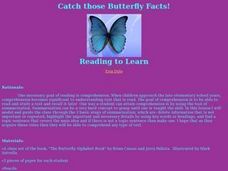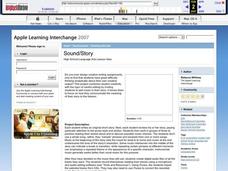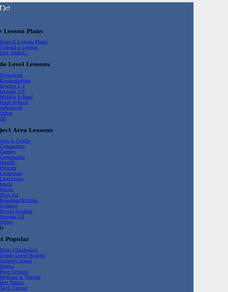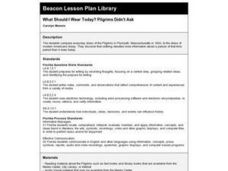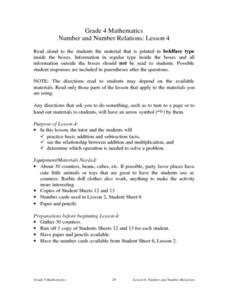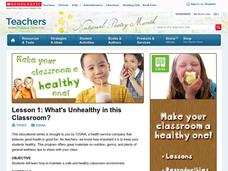Curated OER
Catch those Butterfly Facts!
Discuss the importance of comprehension and the use of summarization with your class. Through guided practice, they follow three steps in finding and highlighting important information, deleting information that is not needed and...
Curated OER
Sound/Story
High schoolers combine creativity with the rigor of careful editing by adding music to their story. It forces them to focus on how they communicate the meaning of their story to the listener.
Curated OER
Ben Franklin Timeline
Celebrate inventions such as lightning rods, bifocals, and stoves with a Ben Franklin Day. Young historians conduct research and write a paragraph about an accomplishment of Benjamin Franklin including an illustration...
EngageNY
Equivalent Ratios II
What is the connection between equivalent ratios? Class members first find the multiplication factor used to create equivalent ratios. Next, they take that information to determine whether ratios are equivalent. The second lesson on...
EngageNY
Modeling an Invasive Species Population
Context makes everything better! Groups use real data to create models and make predictions. Classmates compare an exponential model to a linear model, then consider the real-life implications.
EngageNY
Real-World Positive and Negative Numbers and Zero II
Continuing from the previous lesson in the series, scholars learn to use positive and negative integers to describe real-world situations. In groups, they come up with their own situations for given positive and negative integers.
EngageNY
Advanced Factoring Strategies for Quadratic Expressions (part 1)
Factoring doesn't have to be intimidating. Build on prior knowledge of multiplying binomials and factoring simple trinomials to teach advanced factoring of quadratic expressions with a lesson that uses various methods of exploring the...
Curated OER
GREEK MYTH IN PAINTING
Second graders look closely at a Renaissance painting depicting an ancient Greek myth, review the term renaissance, hear a Greek myth that tells how the peacock got its tail, sequence the story, and identify the actions of the myth in...
Curated OER
The Lewis and Clark Expedition
Students examine the Lewis and Clark expedition. They develop skills for historical analysis. They locate a variety of geographic features encountered by the expedition, and create a timeline that documents Lewis and Clark on their journey.
Curated OER
Beginning At Home
Students participate in activities that increase awareness of environmental stewardship. In this stewardship activity, students discuss solutions to environmental problems and apply the solutions to ways they can keep their classroom...
Curated OER
Snowman in Winter Sequence Writing
Young scholars develop a creative snowman using step-by-step stickers. They write a short story about the snowman they have created, explaining the sequence they used to create their snowman. Students present their completed story in...
Curated OER
Then and Now
First graders explore teacher created exploration tub, charts and cards to explain the concept of "Then and Now."
Curated OER
Pre-K Trivia
Students choose a card from a bag which has a previously agreed upon thought written on it. They answer the question on the card.
Curated OER
Exploring Sounds
Learners identify the "sh"sound with the help of the Florida quarter. Students place the sounds placement within words with this kinesthetic activity. Learners share various examples of consonant blends on the board.
Curated OER
Mural Mania
Students research and discuss symbols and features of their state. They create a mural representing their state and design a quarter for their state.
Curated OER
What Should I Wear Today? Pilgrims Didn't Ask
Second graders compare the clothing of today with the everyday dress of the Pilgrims.
Curated OER
George Washington Carver and Sharing
Learners research George Washington Carver. In this science lesson, students discuss George Washington Carver's contribution to science. Learners explain how peanut butter is produced.
Curated OER
Map the Path in My Father's Dragon
Students listen to Ruth Stiles Gannett's book My Father's Dragon. They predict the outcome of the story. They discuss the events in the story. They sequence the events in the story.
Curated OER
Number and Number Relations: Lesson 4
Fourth graders investigate the use of addition and subtraction facts in different situations. They examine the relationship between addition and multiplication and determine which operation is needed to solve various problematic situations.
Curated OER
Number and Number Relations: Lesson 3
Fourth graders explore the concepts of addition and subtraction. They investigate the relationship between addition and subtraction and determine the operation needed to solve a problem.
Curated OER
Using Information Resources
Eighth graders engage in a lesson that is intended to develop the skills of research to find the proper resources needed to find information. The lesson includes dialogue boxes that is intended for the teacher to use for direct...
Curated OER
Using Information Resources: Lesson 4
Fourth graders review a variety of information resources and identify parts of a book. They practice brainstorming and practice skimming. They review all the research resources that are found in the library.
Curated OER
Cultural Impact of Jim Crow Laws and the Civil Rights Movement
Students examine the Jim Crow laws and how they impacted the lives of both African Americans and white Americans. They discuss the Civil Rights Movement and how their lives may have been different had it not occurred.
Groups...
Curated OER
Lesson 1: What's Unhealthy in this Classroom?
Students discover behaviors and practices that are unhealthy within their classroom environment. In this early childhood lesson plan, students identify behaviors and practices that lead to an unhealthy environment, and discuss how to...


